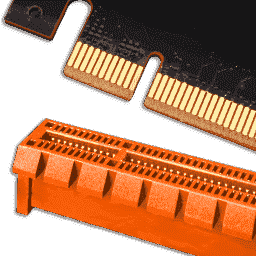NVIDIA GeForce RTX 5060 Ti PCI-Express x8 Scaling
Source: Tech Power Up added 16th Apr 2025Introduction
NVIDIA today launched the GeForce RTX 5060 Ti, the latest entry to its performance-segment. You can read all about the card and how it performs in our main review of the card. This card is a direct successor to the RTX 4060 Ti and the RTX 3060 Ti before it. The RTX 3060 Ti and its sibling, the RTX 3060, came with PCI-Express 4.0 x16 host interfaces, giving them the same host bandwidth as the flagship RTX 3090 graphics card from that generation. Then, with its RTX 40-series, NVIDIA changed its mid-range GPUs such that the AD106 silicon driving the RTX 4060 Ti comes with a PCI-Express 4.0 x8 host interface.
When NVIDIA chose to give the RTX 4060 Ti and the AD106 silicon driving it a PCI_Express 4.0 x8 interface, it justified the move point out to PCIe Gen 4 being prevalent with desktop platforms going all the way back to the 11th Gen Core Rocket Lake and Ryzen 3000 Zen 2—platforms from 2018 and 2019. With the new RTX 50-series Blackwell generation, NVIDIA is implementing PCI-Express Gen 5, which doubles bandwidth over Gen 4, and chose to give the RTX 5060 Ti and the GB206 silicon driving it a PCI-Express 5.0 x8 host interface.
PCI-Express 5.0 x8 provides the same amount of host interface bandwidth as PCI-Express 4.0 x16, which should be taken as great news, but there’s a slight wrinkle. While it’s true that processors with PCIe Gen 5 have been around since 2021, starting with 12th Gen Core Alder Lake on the Intel side and Ryzen 7000 Zen 4 from AMD, not all Socket LGA1700 or Socket AM5 motherboards provide Gen 5 PCI-Express Graphics (PEG) x16 slots. Many of the mid-range motherboards based on mid-tier chipsets, such as the AMD B650, and Intel B660/760 provide Gen 4 x16 slots despite the processors supporting Gen 5, to save on PCIe Gen 5 redrivers and other onboard components. It raises the question on how PCI-Express 4.0 x8 bandwidth could affect the performance of the RTX 5060 Ti compared to its native PCI-Express 5.0 x8.
Our main review sees the RTX 5060 Ti run on a high-end motherboard with a native PCI-Express 5.0 x16 slot, and so the GPU is in its element. In this review, we will subject it to PCI-Express 4.0 x8 and PCI-Express 3.0 x8, to see how the change in host interface bandwidth affects performance. This is particularly important because mid-range and entry-level motherboards tend to lack Gen 5-capable x16 PEG slots, and users from these platforms are likely to opt for a GPU of the price and performance of the RTX 5060 Ti.
To enable PCIe Gen 4 and Gen 3, we used controls in the UEFI BIOS setup program of our MSI MPG X870E Carbon Wi-Fi motherboard. Gen 5 x8 performance numbers, intended to be seen as base data carried over from our main review. Gen 4 x8 is comparable bandwidth to Gen 3 x16 and yet half the bandwidth of the GPU’s original specification. And lastly, Gen 3 x8 is a quarter of the native bandwidth of the RTX 5060 Ti.
media: Tech Power Up
Related posts
Notice: Undefined variable: all_related in /var/www/vhosts/rondea.com/httpdocs/wp-content/themes/rondea-2-0/single-article.php on line 88
Notice: Undefined variable: all_related in /var/www/vhosts/rondea.com/httpdocs/wp-content/themes/rondea-2-0/single-article.php on line 88
Related Products
Notice: Undefined variable: all_related in /var/www/vhosts/rondea.com/httpdocs/wp-content/themes/rondea-2-0/single-article.php on line 91
Warning: Invalid argument supplied for foreach() in /var/www/vhosts/rondea.com/httpdocs/wp-content/themes/rondea-2-0/single-article.php on line 91
